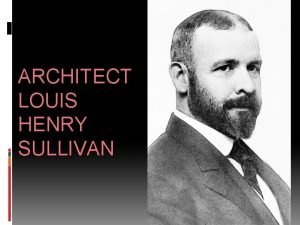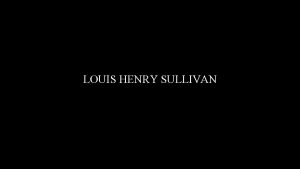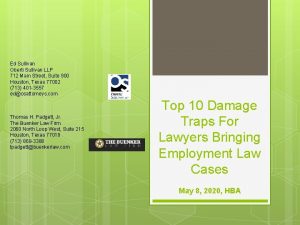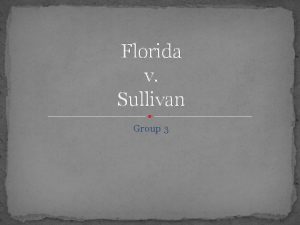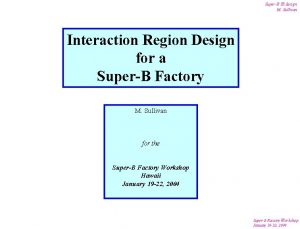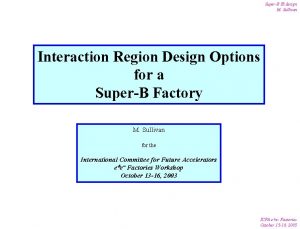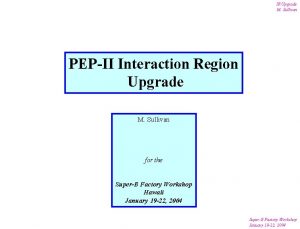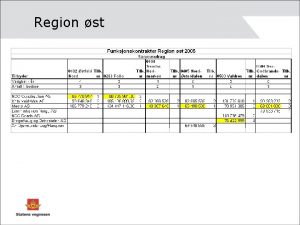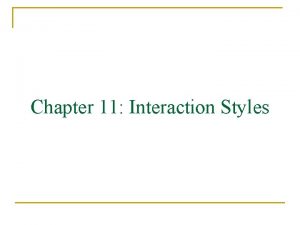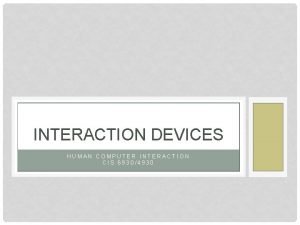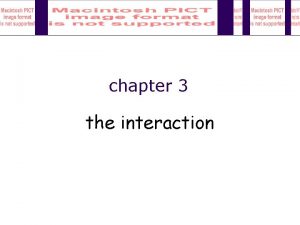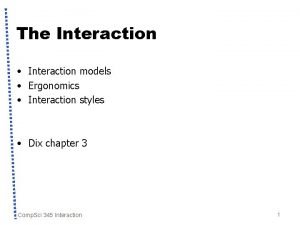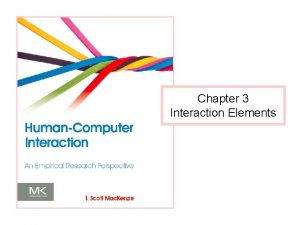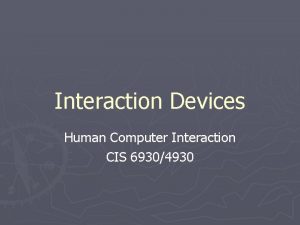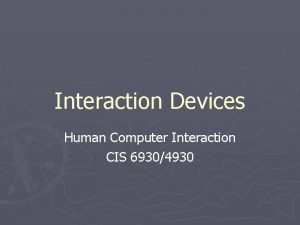Interaction Region The Interaction Region M Sullivan 5






















- Slides: 22

Interaction Region The Interaction Region M. Sullivan 5 th Super. B Workshop Paris May 9 -11, 2007 1 5 th Super. B Workshop May 9 -11, 2007

Interaction Region Outline • Design Issues • IR Design • Toward an improved design • Summary 2 5 th Super. B Workshop May 9 -11, 2007

Interaction Region Detector Considerations • Reasonable angular acceptance – ± 300 mrad • Small radius beam pipe – 10 mm radius • Thin beam pipe • SR backgrounds – Rates comparable to PEP-II • Few hits per crossing on Be beam pipe • Little or no hits on nearby beam pipes 3 5 th Super. B Workshop May 9 -11, 2007

Interaction Region Detector Considerations (2) • BGB backgrounds – Keep nearby upstream bending to a minimum – Suggest upstream bending further away from the detector (>10 m) to minimize the BGB integral – Low vacuum pressure upstream of the detector 4 5 th Super. B Workshop May 9 -11, 2007

Interaction Region Detector Considerations (3) • Luminosity backgrounds – Beam lifetimes – Radiative bhabhas – Beam-beam • Local HOM power – Small diameter beam pipes trap higher frequencies – Always get modes when two pipes merge to one 5 5 th Super. B Workshop May 9 -11, 2007

Interaction Region Accelerator parameters Energy (Ge. V) Current (A) No. bunches Bunch spacing (m) Beat x* (mm) Beta y* (mm) Emittance x (nm-rad) Emittance y (pm-rad) Full crossing angle (mrad) LER 4. 0 3. 95 HER 7. 0 2. 17 3466 0. 63 20 0. 2 1. 6 4 34 These parameters constrain or define the IR design 6 5 th Super. B Workshop May 9 -11, 2007

Interaction Region Summary of Present Design • Crossing angle of ± 17 mrad • Beam pipe diameter of 20 mm at the end of QD 0 for both beams (same size as IP pipe) • This leaves enough room (~10 mm) to place a permanent magnet quadrupole and get the required strength (Using Br = 14 k. G) • We have placed small bending magnets between QD 0 and QF 1 on the incoming beam lines to redirect the QF 1 SR • The septum QF 1 magnets for the outgoing beams are tilted in order to let the strong SR fans escape • The outgoing beams B 0 magnets are a C shape design in order to allow the strong SR fans to escape 7 5 th Super. B Workshop May 9 -11, 2007

Interaction Region IR design parameters 8 L* QD 0 H B 00 L B 00 H QF 1 L QF 1 H B 0 L B 0 H Length 0. 30 m 0. 46 m 0. 29 m 0. 40 m 2. 0 m QD 0 offset 6. 00 mm 7. 50 mm Starts at 0. 0 0. 30 m 0. 76 m -1. 05 m ± 1. 45 m ± 2. 05 m Strength -820. 6 k. G/m -2. 2 k. G 1. 5 k. G 293. 2 k. G/m 589. 1 k. G/m 0. 3 k. G 0. 526 k. G Comments Drift Both HER and LER HER only Incoming LER only Incoming HER only LER only (sign? ) HER only (sign? ) Incoming HER Incoming LER 5 th Super. B Workshop May 9 -11, 2007

Interaction Region SR Power Numbers The design (G 3) has a total SR power comparable to PEP-II SR power in QD 0 (k. W) for beam currents of 1. 44 A HER and 2. 5 A LER No QD 0 offsets Ver. F 1 Ver. G 3 PEP-II 3 A on 1. 8 A Incoming HER 41 9 4 49 Incoming LER 28 1 1 16 Outgoing HER 41 152 93 49 Outgoing LER 28 67 55 16 138 230 153 130 Total 9 5 th Super. B Workshop May 9 -11, 2007

Interaction Region 10 5 th Super. B Workshop May 9 -11, 2007

Interaction Region LER SR fans 11 5 th Super. B Workshop May 9 -11, 2007

Interaction Region HER SR fans 12 5 th Super. B Workshop May 9 -11, 2007

Interaction Region ± 1 meter 13 5 th Super. B Workshop May 9 -11, 2007

Interaction Region SR fans 14 5 th Super. B Workshop May 9 -11, 2007

Interaction Region Some SR background details • We are using a gaussian beam distribution with a second wider and lower gaussian simulating the “beam tails” • The beam distribution parameters are the same as the ones used for PEP-II • We allow particles out to 10 in x and 35 in y to generate SR • Unlike in PEP-II the SR backgrounds in the Super. B are dominated by the particle distribution at large beam sigma, so we are more sensitive to the exact particle distribution out there 15 5 th Super. B Workshop May 9 -11, 2007

Interaction Region Radiative Bhabhas • The outgoing beams are still significantly bent as they go through QD 0 • Therefore the off-energy beam particles from radiative bhabhas will get swept out • Knowing this, we will have to build in shielding for the detector 16 5 th Super. B Workshop May 9 -11, 2007

Interaction Region HER radiative bhabhas 17 5 th Super. B Workshop May 9 -11, 2007

Interaction Region LER radiative bhabhas 18 5 th Super. B Workshop May 9 -11, 2007

Interaction Region How to improve the design • The best improvement would be to reduce the radiative bhabha background – Note that there is only a small gain in beam separation from the strong outgoing bending because one has to allow the outgoing SR to escape (see slide 14) – The only gain comes from the BSC moving away from the septum 19 5 th Super. B Workshop May 9 -11, 2007

Interaction Region Attempts to improve the design • Three possibilities so far looked at – Reduce the strength of the shared element • Difficult to control beta functions (Can’t let the beta functions get too big) – Try a high strength but very short and close to the IP shared element (minimal off-axis trajectories) • Need a VERY high strength field to control beta functions • High field still bends a beam even with a small off-axis traj. – Eliminate the shared element • Wants a maximum crossing angle (± 24 mrads? ) • Can start one focusing magnet for one of the beams first and then follow with the focusing magnet for the other beam as soon as possible • Still need to control beta functions • Just got started on this option: no conclusion yet 20 5 th Super. B Workshop May 9 -11, 2007

Interaction Region More designs • Other possibilities thought about – A longer, weaker shared element • End up with more bending at the outboard end • Wants a minimal crossing angle • Difficult to control beta functions – Asymmetric IR (more like ILC? ) • Well controlled incoming beta functions • Outgoing beta functions allowed to get bigger • OK for ILC—not so good for storage rings 21 5 th Super. B Workshop May 9 -11, 2007

Interaction Region Summary • We have an IR design that has acceptable SR backgrounds with a crossing angle of ± 17 mrad an energy asymmetry of 7 x 4 • The BGB and coulomb scattered beam particles as a background need to be calculated and controlled (been done? ) • Radiative bhabha backgrounds are still high due to the strong bending of the outgoing beams • The total SR power generated by the IR is high for the same reason. This can cause emittance growth. Especially vertical emittance growth since this is in a coupled region. • A through exploration of parameter space is needed to find the best IR design 22 5 th Super. B Workshop May 9 -11, 2007
 Sơ đồ cơ thể người
Sơ đồ cơ thể người Công thức tính thế năng
Công thức tính thế năng Số nguyên là gì
Số nguyên là gì Tư thế ngồi viết
Tư thế ngồi viết Tỉ lệ cơ thể trẻ em
Tỉ lệ cơ thể trẻ em đặc điểm cơ thể của người tối cổ
đặc điểm cơ thể của người tối cổ Các châu lục và đại dương trên thế giới
Các châu lục và đại dương trên thế giới Phản ứng thế ankan
Phản ứng thế ankan ưu thế lai là gì
ưu thế lai là gì Thẻ vin
Thẻ vin Các môn thể thao bắt đầu bằng tiếng nhảy
Các môn thể thao bắt đầu bằng tiếng nhảy Cái miệng bé xinh thế chỉ nói điều hay thôi
Cái miệng bé xinh thế chỉ nói điều hay thôi Hát kết hợp bộ gõ cơ thể
Hát kết hợp bộ gõ cơ thể Từ ngữ thể hiện lòng nhân hậu
Từ ngữ thể hiện lòng nhân hậu Trời xanh đây là của chúng ta thể thơ
Trời xanh đây là của chúng ta thể thơ Tư thế ngồi viết
Tư thế ngồi viết Gấu đi như thế nào
Gấu đi như thế nào V. c c
V. c c Thể thơ truyền thống
Thể thơ truyền thống Khi nào hổ mẹ dạy hổ con săn mồi
Khi nào hổ mẹ dạy hổ con săn mồi đại từ thay thế
đại từ thay thế Thế nào là hệ số cao nhất
Thế nào là hệ số cao nhất Diễn thế sinh thái là
Diễn thế sinh thái là























